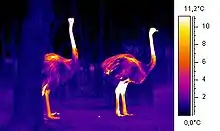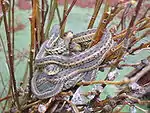Kleptothermy
Kleptothermy is any form of thermoregulation by which an animal shares in the metabolic thermogenesis of another animal. It may or may not be reciprocal, and occurs in both endotherms and ectotherms.[1] One of its forms is huddling. However, kleptothermy can happen between different species that share the same habitat, and can also happen in pre-hatching life where embryos are able to detect thermal changes in the environment.
| Thermoregulation in animals |
|---|
 |
This process requires two major conditions: the thermal heterogeneity created by the presence of a warm organism in a cool environment in addition to the use of that heterogeneity by another animal to maintain body temperatures at higher (and more stable) levels than would be possible elsewhere in the local area.[2] The purpose of this behaviour is to enable these groups to increase its thermal inertia, retard heat loss and/or reduce the per capita metabolic expenditure needed to maintain stable body temperatures.[2]
Kleptothermy is seen in cases where ectotherms regulate their own temperatures and exploit the high and constant body temperatures exhibited by endothermic species.[2] In this case, the endotherms involved are not only mammals and birds; they can be termites that maintain high and constant temperatures within their mounds where they provide thermal regimes that are exploited by a wide array of lizards, snakes and crocodilians. However, many cases of kleptothermy involve ectotherms sheltering inside the burrows used by endotherms to help maintain a high a constant body temperature.[2]
Huddling

Huddling confers higher and more constant body temperatures than solitary resting.[3] Some species of ectotherms including lizards[4] and snakes, such as boa constrictors[5] and tiger snakes,[6] increase their effective mass by clustering tightly together. It is also widespread amongst gregarious endotherms such as bats[7] and birds (such as the mousebird[8] and emperor penguin[9]) where it allows the sharing of body heat, particularly among juveniles.
In white-backed mousebirds (Colius colius), individuals maintain rest-phase body temperature above 32 °C despite air temperatures as low as -3.4 °C.[10] This rest-phase body temperature was synchronized among individuals that cluster.[10] Sometimes, kleptothermy is not reciprocal and might be accurately described as heat-stealing. For example, some male Canadian red sided garter snakes engage in female mimicry in which they produce fake pheromones after emerging from hibernation.[11] This causes rival males to cover them in a mistaken attempt to mate, and so transfer heat to them.[11] In turn, those males that mimic females become rapidly revitalized after hibernation (which depends upon raising their body temperature), giving them an advantage in their own attempts to mate.[11]
.jpg.webp)
On the other hand, huddling allows emperor penguins (Aptenodytes forsteri) to save energy, maintain a high body temperature and sustain their breeding fast during the Antarctic winter.[12] This huddling behaviour raises the ambient temperature that these penguins are exposed to above 0 °C (at average external temperatures of -17 °C).[12] As a consequence of tight huddles, ambient temperatures can be above 20 °C and can increase up to 37.5 °C, close to birds' body temperature.[12] Therefore, this complex social behaviour is what enables all breeders to get an equal and normal access to an environment which allows them to save energy and successfully incubate their eggs during the Antarctic winter.[12]
Habitat sharing
Many ectotherms exploit the heat produced by endotherms by sharing their nests and burrows. For example, mammal burrows are used by geckos and seabird burrows by Australian tiger snakes and New Zealand tuatara.[13] Termites create high and regulated temperatures in their mounds, and this is exploited by some species of lizards, snakes and crocodiles.[14][15]
Research has shown such kleptothermy can be advantageous in cases such as the blue-lipped sea krait (Laticauda laticaudata), where these reptiles occupy a burrow of a pair of wedge-tailed shearwater incubating their chick.[2] This in turn, raises its body temperature to 37.5 °C (99.5 °F), compared to 31.7 °C (89.1 °F) when present in other habitats.[2] Its body temperature is also observed to be more stable.[2] On the other hand, burrows without birds did not provide this heat, being only 28 °C (82 °F).[2]
Another example would be the case of the fairy prion (Pachyptila turtur) that forms a close association with a medium-sized reptile, the tuatara (Sphenodon punctatus).[16] These reptiles share the burrows made by the birds, and often stay when the birds are present which helps maintain a higher body temperature.[16] Research has shown that fairy prions enable tuatara to maintain a higher body temperature through the night for several months of the year, October to January (austral spring to summer).[16] During the night, tuatara sharing a burrow with a bird had the most thermal benefits and helped maintain their body temperature up to 15 hours the next day.[16]
Pre-hatching life
Research done on embryos of Chinese softshell turtles (Pelodiscus sinensis) falsify the assumption that behavioural thermoregulation is possible only for post-hatching stages of the reptile life history.[17] Remarkably, even undeveloped and tiny embryos were able to detect thermal differentials within the egg and move to exploit that small-scale heterogeneity.[17] Research has shown that this behaviour exhibited by reptile embryos may well enhance offspring fitness where movements of these embryos enabled them to maximize heat gain from their surroundings and thus increase their body temperatures.[17] This in turn leads to a variation in the embryonic development rate and the incubation period as well.[17] This could benefit the embryos in which a warmer incubation increases developmental rate and therefore accelerating the hatching process.[17]
On the other hand, decreased incubation periods also may minimize the embryo's exposure to risks of nest predation or lethal extremes thermal conditions where embryos move to cooler regions of the egg during periods of dangerously high temperatures.[17]
In addition, embryonic thermoregulation could enhance hatching fitness via modifications to a range of phenotypic traits where embryos with minimal temperature differences hatch at the same time decreasing the individuals' risk of predation.[17] Therefore, the developmental rates of embryos of reptiles are not passive consequences of maternally enforced decisions about the temperatures that the embryo will experience before hatching.[17] Instead, the embryo's behaviour and physiology combine, allowing the smallest embryos to control aspects of their own pre-hatching environment showing that the embryo is not simply a work in progress, but is a functioning organism with surprisingly sophisticated and effective behaviours.[17]
Evolution
Ectotherms and endotherms undergo different evolutionary perspectives where mammals and birds thermoregulate far more precisely than ectotherms.[18]A major benefit of precise thermoregulation is the ability to enhance performance through thermal specialization.[18] Therefore, mammals and birds are assumed to have evolved relatively narrow performance breadths.[18] Thus, the heterothermy of these endotherms would lead to losses of performance during certain periods and therefore genetic variation in thermosensitivity would enable the evolution of thermal generalists in more heterothermic species.[18] The physiologies of the endotherms allows them to adapt within the constraints imposed by genetics, development, and physics.[18]
On the other side, the mechanisms for thermoregulation did not evolve separately,but rather in connection with other functions.[19] These mechanisms were more likely quantitative rather than qualitative and it involved selection of appropriate habitats, changes in levels of locomotor activity, optimum energy liberation, and conservation of metabolic substrates.[19] The evolution of endothermy is directly linked to the selection for high levels of activity sustained by aerobic metabolism.[20] The evolution of the complex behaviour patterns among the birds and mammals requires the evolution of metabolic systems that support the activity prior to that.[20]
Endothermy in vertebrates evolved along separate, but parallel lines from different groups of reptilian ancestors.[20] The advantages of endothermy are manifested in the ability to occupy thermal areas that exclude many ectothermic vertebrates, a high degree of thermal independence from environmental temperature, high muscular power output and sustained levels of activity.[20] Endothermy, however, is energetically very expensive and requires a great deal of food, compared with ectotherms in order to support high metabolic rates.[20]
See also
References
- The Royal Society. Kleptothermy: an additional category of thermoregulation, and a possible example in sea kraits (Laticauda laticaudata, Serpentes)
- Brischoux, François; Bonnet, Xavier; Shine, Richard (2009). "Kleptothermy: An additional category of thermoregulation, and a possible example in sea kraits (Laticauda laticaudata, Serpentes)". Biology Letters. 5 (6): 729–731. doi:10.1098/rsbl.2009.0550. PMC 2828009. PMID 19656862.
- Eppley, Timothy M.; Watzek, Julia; Hall, Katie; Donati, Giuseppe (2017-12-01). "Climatic, social and reproductive influences on behavioural thermoregulation in a female-dominated lemur". Animal Behaviour. 134: 25–34. doi:10.1016/j.anbehav.2017.10.003. ISSN 0003-3472.
- "Sociality in Lizards: Why do Thick-tailed Geckos (Nephrurus milii) Aggregate?". Behaviour. 140 (8–9): 1039–1052. 2003. doi:10.1163/156853903322589632.
- Myres, BC; Eells, MM (1968). "Thermal aggregation in Boa constrictor". Herpetologica. 24 (1): 61–66. JSTOR 3891156.
- Aubret, Fabien; Shine, Richard (2009). "Causes and consequences of aggregation by neonatal tiger snakes (Notechis scutatus, Elapidae)". Austral Ecology. 34 (2): 210–217. doi:10.1111/j.1442-9993.2008.01923.x.
- Arends, Alexis; Bonaccorso, Frank J.; Genoud, Michel (1995). "Basal Rates of Metabolism of Nectarivorous Bats (Phyllostomidae) from a Semiarid Thorn Forest in Venezuela". Journal of Mammalogy. 76 (3): 947. doi:10.2307/1382765. JSTOR 1382765.
- Brown, C. R.; Foster, G. G. (1992). "The thermal and energetic significance of clustering in the speckled mousebird, Colius striatus". Journal of Comparative Physiology B. 162 (7): 658–664. doi:10.1007/BF00296648.
- Ancel, André; Visser, Henk; Handrich, Yves; Masman, Dirkjan; Maho, Yvon Le (1997). "Energy saving in huddling penguins". Nature. 385 (6614): 304–305. Bibcode:1997Natur.385..304A. doi:10.1038/385304a0.
- McKechnie, Andrew E.; Körtner, Gerhard; Lovegrove, Barry G. (2004). "Rest-Phase Thermoregulation in Free-Ranging White-Backed Mousebirds". The Condor. 106 (1): 143. doi:10.1650/7327. ISSN 0010-5422.
- Shine, R.; Phillips, B.; Waye, H.; Lemaster, M.; Mason, R. T. (2001). "Benefits of female mimicry in snakes". Nature. 414 (6861): 267. Bibcode:2001Natur.414..267S. doi:10.1038/35104687. PMID 11713516.
- Gilbert, C; Robertson, G; Lemaho, Y; Naito, Y; Aancel, A (2006-07-30). "Huddling behavior in emperor penguins: Dynamics of huddling". Physiology & Behavior. 88 (4–5): 479–488. arXiv:q-bio/0701051. doi:10.1016/j.physbeh.2006.04.024. ISSN 0031-9384. PMID 16740281.
- Newman, DG (1987). "Burrow use and population densities of Tuatara (Sphenodon punctatus) and how they are influenced by fairy prions (Pachyptila turtur) on Stephens Island, New Zealand". Herpetologica. 43 (3): 336–344. JSTOR 3892500.
- Ehmann, H; Swan, G; Swan, G; Smith, B (1991). "Nesting, egg incubation and hatching by the heath monitor Varanus rosenbergi in a termite mound". Herpetofauna. 21: 17–24.
- Knapp, Charles R.; Owens, Audrey K. (2008). "Nesting Behavior and the Use of Termitaria by the Andros Iguana (Cyclura cychlura cychlura)". Journal of Herpetology. 42: 46–53. doi:10.1670/07-098.1.
- Corkery, Ilse; Bell, Ben D.; Nelson, Nicola J. (March–April 2014). "Investigating Kleptothermy: A Reptile-Seabird Association with Thermal Benefits". Physiological and Biochemical Zoology. 87 (2): 216–221. doi:10.1086/674566. ISSN 1522-2152. PMID 24642539.
- Du, Wei-Guo; Zhao, Bo; Chen, Ye; Shine, Richard (2011). "Behavioral thermoregulation by turtle embryos". Proceedings of the National Academy of Sciences of the United States of America. National Academy of Sciences. 108 (23): 9513–5. Bibcode:2011PNAS..108.9513D. doi:10.1073/pnas.1102965108. OCLC 811394739. PMC 3111322. PMID 21606350.
- Cooper, Brandon S (2010). "The evolution of thermal physiology in endotherms". Frontiers in Bioscience. E2 (3): 861–881. doi:10.2741/e148. ISSN 1945-0494. PMID 20515760.
- Ornston, L. N. (2003-01-25). "Evolution of Regulatory Mechanisms in Bacteria". Fort Belvoir, VA. doi:10.21236/ada417800. Cite journal requires
|journal=(help) - Bennett, A.; Ruben, J. (1979-11-09). "Endothermy and activity in vertebrates". Science. 206 (4419): 649–654. Bibcode:1979Sci...206..649B. doi:10.1126/science.493968. ISSN 0036-8075. PMID 493968.